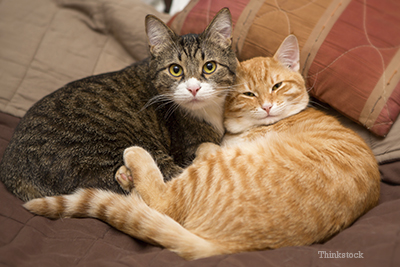
What is pyothorax?
Pyothorax, which is a fancy way of saying that pus is in the chest cavity, is a life-threatening, severe infection that can be seen in both dogs and cats. While rare, it can be devastating, as it requires aggressive treatment (including chest tube placement, surgery, etc.). Pyothorax is different from pneumonia, as it is caused by abnormal infection in the thorax, not in the lungs themselves (versus bacterial pneumonia, which is an infection within the lung). Note that this doesn’t mean that there is pus in the lungs, but rather in the sterile space surrounding the lungs. As more and more pus accumulates in the pleural cavity (which is the space surrounding your lungs and heart), it compresses the lungs, making breathing more difficult. Also, the pus can result in septic shock, an overwhelming bacterial infection in the bloodstream. Pyothorax is seen more frequently in cats than dogs, and is due to an infection that progressed into the chest cavity. One study has shown that cats that come from multi-cat households are almost 4 times more likely to develop pyothorax than cats that live alone (this is likely due to fighting).1 Likewise, younger cats are often more likely to develop pyothorax than older cats.1 Cats that go outside and potentially fight with other cats are also at greater risk because a bite wound to the thorax can result in a pyothorax.
Pyothorax is seen more frequently in cats than dogs, and is due to an infection that progressed into the chest cavity. One study has shown that cats that come from multi-cat households are almost 4 times more likely to develop pyothorax than cats that live alone (this is likely due to fighting).1 Likewise, younger cats are often more likely to develop pyothorax than older cats.1 Cats that go outside and potentially fight with other cats are also at greater risk because a bite wound to the thorax can result in a pyothorax.
Symptoms of pyothorax
Unfortunately, clinical signs of pyothorax can be very subtle, so it’s important to be aware of signs of this problem in your cat. Signs of difficulty breathing make for an immediate trip to the emergency room – even if it’s in the middle of the night!
Signs of pyothorax in cats include:
- Lethargy or not moving much
- Drooling
- Not eating/anorexia
- Hiding in unusual places (e.g., under the bed, in the closet, etc.)
- Warm to the touch
- Fever
- A slow heart rate1 or abnormally elevated heart rate
- Vomiting
- Dehydration
- An increased respiratory rate > 40 breaths per minute (bpm) or constant panting
- Seeming out of shape during a walk (e.g., exercise intolerance)
- Hunched over in sternal
- Open mouth breathing (unless it’s a stressful event like a car ride, this is always abnormal, as cats prefer to always breath through their nostrils)
- Difficulty breathing
- Blue-tinged gums (which indicates severe difficulty and possible death if not treated immediately)
- Stretching the neck out to breath
- Sitting up to breath, with the front legs/elbow spread out (like a English bulldog stance)
- Using the abdomen to breath better (you’ll notice the sides of the belly heaving in and out more)
** Note that this list of signs isn’t all-inclusive, but if you notice any of these signs, a visit to the veterinarian or emergency veterinarian is a must.
Treatment of pyothorax
Certain tests and treatments need to be initiated as soon as your pet is diagnosed with a pyothorax. These include:
- Life-saving stabilization, including oxygen therapy
- Analysis (called “cytology”) of the fluid, to look for certain types of bacteria
- Culture of the fluid to make sure the appropriate antibiotics are used
- Blood work (to evaluate the white and red blood cells, platelets, kidney and liver function, electrolytes, and clotting ability)
- Monitoring of the blood oxygen levels (e.g., with a pulse oximetry [a device that non-invasively monitors how much oxygen is being carried by the red blood cells] or an arterial blood gas [a sample of the blood from the artery])
- A thoracocentesis, which is when a sterile needle is placed into the chest cavity to remove the pus from the chest cavity. This helps improve breathing difficulty immediately.
- Chest x-rays (to look at the appearance of the trachea, ribs, lungs, diaphragm, etc.) after the abnormal fluid has been removed
- Sometimes, a clotting test (called a prothrombin [PT] or activated partial thromboplastin time [aPTT]) may be necessary, particularly if there is the concern about anticoagulant mouse and rat poisoning causing internal bleeding
- IV fluids to help hydrate
- Aggressive antibiotics (ideally intravenously) to fight the overwhelming infection; this typically needs to be continued for weeks
- Placement of chest tubes to drain the pus from the chest cavity
- Pain medication (as chest tubes are very uncomfortable!)
- A CT or MRI to look for underlying causes for the infection (e.g., looking for an abscess or source of infection)
- Surgery to remove the source of infection
The prognosis for pyothorax is generally good, provided that aggressive medical or surgical management can take place immediately. However, once signs of septic shock have developed, the prognosis is poor. For this reason, the sooner you notice a problem, the sooner you want to seek veterinary attention!
If you have any questions or concerns, you should always visit or call your veterinarian -- they are your best resource to ensure the health and well-being of your pets.
Source:
- Waddell LS, Brady CA, Drobatz KJ. Risk factors, prognostic indicators, and outcome of pyothorax in cats: 80 cases (1986-1999). J Am Vet Med Assoc 2002;221(6):819-824.
